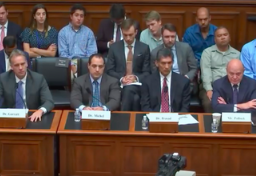The next time you travel to Sweden, you can leave your krona at home. In response to a rise in mobile payment platforms, the nation has become increasingly cashless, and many local businesses no longer accept bills or coins. With the rise of mobile payment apps like Venmo and Square Cash, and cryptocurrencies like bitcoin, is the United States headed in the same direction?
Probably, says UC Santa Barbara professor of economics Rod Garratt, who believes financial institutions and consumers alike should prepare for a future with much less physical cash. An expert in digital currencies, Garratt recently spoke about the issue in front of the U.S. House of Representatives Subcommittee on Monetary Policy and Trade at a hearing on the future of money. He discussed a number of different scenarios for the decline of cash, and how they could affect both banks and consumers.
“There are multiple ways that things could unfold as cash disappears,” Garratt said in a subsequent interview. “One possibility is that people will be content to transact primarily in commercial bank deposits and things will be business as usual only with much less cash around. Another possibility is that people will demand direct access to some form of digital, central bank-issued money, as a replacement for cash. And a third possibility is that people will turn to privately issued cryptocurrencies, like bitcoin.”
Garratt believes that central banks should be prepared to handle any of these possibilities. “Central banks might want to be proactive here,” he said. “I’m thinking about a future world where cash use has declined to the point where it is starting to disappear. The question is, do the central banks get out of that game altogether? Or do they offer a substitute? I think they should at least be working towards offering a substitute.”
Although he recognizes that there is a long way to go before central banks are ready to release their own cryptocurrency, Garratt said he is excited by the competition new cryptocurrencies have brought to the traditional payment platforms, and argues that it will lead to innovations that benefit the country as a whole.
Ultimately, Garratt believes it is only a matter of time before the U.S. goes the way of Sweden and cash becomes a rarity. “There’s a tipping point,” he said, “where even if some people still want to use cash, businesses and banks will stop wanting to deal with it.”
But we are not there yet, he emphasized. “The San Francisco Fed does a survey, and if you look at the data, in 2012 the use of cash in transactions was 14 percent by value, 40 percent by volume,” Garratt said. “Those numbers are down to 8 percent and 31 percent in 2016.” In contrast, he pointed out that cash use in transactions in Sweden is below 2 percent by value.
As we head toward a future with fewer dollar bills, Garratt said it will be up to banks and to policymakers to respond to the needs of the population by embracing change and providing or endorsing other forms of currency. “Conventional payment platforms work very well in the United States and they are getting better all the time,” he said. “But the payments landscape is continually evolving and cryptocurrencies are likely here to stay. What I would like central banks to do is be prepared to compete in this space.”
Related Link:
News Date:
Thursday, August 9, 2018
August 31, 2018 - 10:19am







